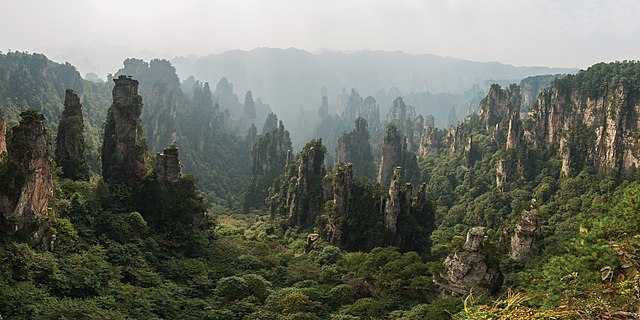
How Tall are the Pillars in Zhangjiajie?
Zhangjiajie National Forest Park, located in Hunan Province, China, is a UNESCO World Heritage Site renowned for its breathtaking landscape. The park is characterized by towering sandstone pillars, lush valleys, sparkling streams, and mist-shrouded peaks, creating a scene straight out of a fantasy novel. One of the most captivating features of Zhangjiajie is undoubtedly its unique rock formations, some of which reach staggering heights.
The Formation of Zhangjiajie's Sandstone Pillars
These awe-inspiring pillars were sculpted over millions of years by a combination of tectonic uplift and erosion. The region was once submerged beneath a shallow sea, where layers of sandstone were deposited over time. As the Earth's tectonic plates shifted, the area experienced uplift, causing the sandstone to rise above sea level.
Exposure to the elements, particularly wind and water, initiated the erosion process. Rainwater, slightly acidic due to dissolved carbon dioxide, seeped into cracks and crevices within the sandstone. Over time, this acidic water dissolved the weaker rock, gradually widening the gaps and leaving behind the more resistant pillars.
The Height of the Pillars
The pillars of Zhangjiajie vary considerably in height, with some reaching incredible heights that dwarf even the tallest trees.
| Pillar Name | Height (meters) | Height (feet) |
|---|---|---|
| Southern Sky Column (Avatar Hallelujah Mountain) | 1,080 | 3,543 |
| Qiankun Pillar | 1,074 | 3,523 |
| Avatar Floating Mountain | 350-500 (estimated) | 1,148-1,640 (estimated) |
Please Note: The height of some pillars, like the Avatar Floating Mountain, is difficult to definitively determine due to their irregular shapes and the surrounding terrain.
Factors Influencing Perceived Height
While the table provides a general idea of the pillars' heights, it's important to consider that several factors can influence how tall they appear to visitors:
- Perspective: The viewing angle and distance from a pillar can dramatically affect its perceived height.
- Surrounding Terrain: Pillars situated in deep valleys or surrounded by lower-elevation areas tend to appear taller.
- Weather Conditions: Mist and fog can obscure the base of the pillars, making them seem as if they are floating in the air and enhancing their height.
Conclusion
The sandstone pillars of Zhangjiajie are a testament to the power of nature's artistry. Their staggering heights, sculpted over eons, contribute to the park's ethereal beauty and make it a truly unforgettable destination for travelers from around the globe. Whether shrouded in mist or bathed in sunlight, these natural skyscrapers never fail to leave a lasting impression on those fortunate enough to witness them.
FAQs
How long did it take for the pillars to form?
The formation of the pillars is an ongoing process that has spanned millions of years. Erosion continues to shape the landscape even today, albeit very slowly.
What is the best time of year to visit Zhangjiajie?
Spring (April-May) and autumn (September-October) are generally considered the best times to visit Zhangjiajie, as the weather is pleasant with comfortable temperatures and fewer crowds.
Is it safe to climb the pillars?
Climbing the pillars is strictly prohibited for safety reasons. The park offers numerous well-maintained trails and viewing platforms that provide stunning panoramic views of the formations.